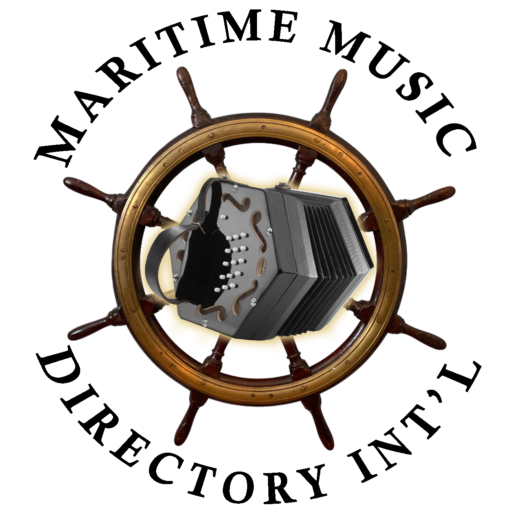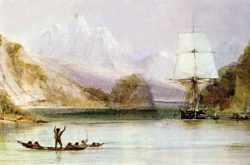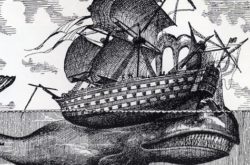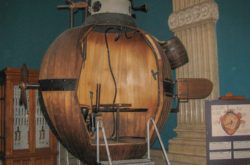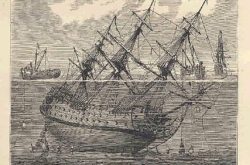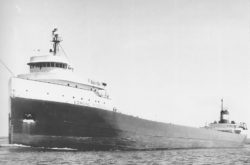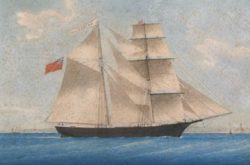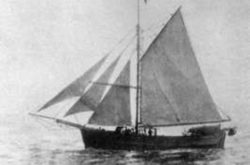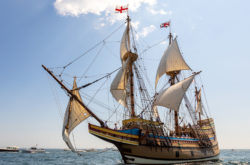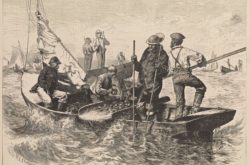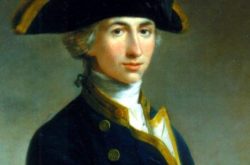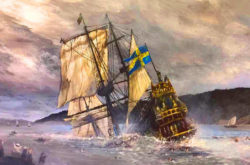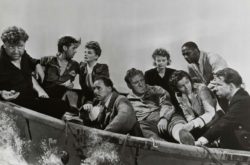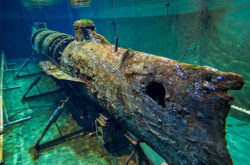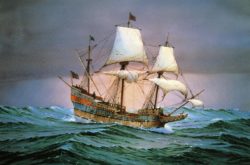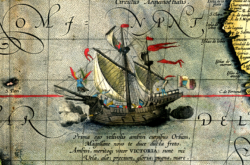Darwin Returns to Falmouth 2 Oct 1831
The British naturalist Charles Darwin returns to Falmouth, England, aboard the HMS Beagle, ending a five-year surveying expedition of the southern Atlantic and Pacific oceans. Visiting such diverse places as Brazil, the Galapagos Islands, and New Zealand, Darwin acquired an intimate knowledge of the flora, fauna, and geology of many lands. This information proved invaluable in the development of his theory of evolution, first put forth in his groundbreaking scientific work of 1859, The Origin of Species by Means of Natural Selection. Darwin’s theory argued that organisms gradually evolve through a process he called “natural selection.” In natural selection, organisms with genetic variations that suit their environment tend to propagate more descendants than organisms of the same species that lack the variation, thus influencing the overall genetic makeup of the species. His Origin of Species, the first significant work on the theory of evolution, was greeted with great interest in the scientific world but was attacked by religious leaders for its contradiction of the biblical account of creation. Read a complete article on National Geographic’s website: https://education.nationalgeographic.org/resource/hms-beagle-darwins-trip-around-world
Whaleship Essex Sunk by Sperm Whale
The American whaler Essex, which hailed from Nantucket, Massachusetts, is attacked by an 80-ton sperm whale 2,000 miles from the western coast of South America. The 238-ton Essex was in pursuit of sperm whales, specifically the precious oil and bone that could be derived from them, when an enraged bull whale rammed the ship twice and capsized the vessel. The 20 crew members escaped in three open boats, but only five of the men survived the harrowing 83-day journey to the coastal waters of South America, where they were picked up by other ships. Most of the crew resorted to cannibalism during the long journey, and at one point men on one of the long boats drew straws to determine which of the men would be shot in order to provide sustenance for the others. Three other men who had been left on a desolate Pacific island were saved later. The first capture of a sperm whale by an American vessel was in 1711, marking the birth of an important American industry that commanded a fleet of more than 700 ships by the mid 18th century. Herman Melville’s classic novel Moby Dick (1851) was inspired in part by the story of the Essex. Read the Complete article on History.com.
World’s First Submarine Attack (Sept. 7, 1776)
On September 7, 1776, during the Revolutionary War, the American submersible craft Turtle attempts to attach a time bomb to the hull of British Admiral Richard Howe’s flagship Eagle in New York Harbor. It was the first use of a submarine in warfare. Submarines were first built by Dutch inventor Cornelius van Drebel in the early 17th century, but it was not until 150 years later that they were first used in naval combat. David Bushnell, an American inventor, began building underwater mines while a student at Yale University. Deciding that a submarine would be the best means of delivering his mines in warfare, he built an eight-foot-long wooden submersible that was christened the Turtle for its shape. Large enough to accommodate one operator, the submarine was entirely hand-powered. Lead ballast kept the craft balanced. Read full article in History.com
Royal George Sinks During Refitting (August 29, 1782)
Royal George sank on 29 August 1782 whilst anchored at Spithead off Portsmouth. The ship was intentionally rolled so maintenance could be performed on the hull, but the roll became unstable and out of control; the ship took on water and sank. More than 800 lives were lost, making it one of the most deadly maritime disasters in British territorial waters. Several attempts were made to raise the vessel, both for salvage and because she was a major hazard to navigation in the Solent. In 1782, Charles Spalding recovered fifteen 12-pounder guns using a diving bell of his own design. From 1834 to 1836, Charles and John Deane recovered more guns using a diving helmet they had invented. In 1839 Charles Pasley of the Royal Engineers commenced operations to break up the wreck using barrels of gunpowder. Pasley’s team recovered more guns and other items between 1839 and 1842. In 1840, they destroyed the remaining structure of the wreck in an explosion which shattered windows several miles away in Portsmouth and Gosport. Link to full article on Wikipedia.
Mary Rose Sinks
Mary Rose Sinks (1545) Several theories are thought to explain how and why Henry VIII’s flag ship sunk at the Battle of Solent. Recovered in 1982 and is now on display in Portsmouth, UK. Mary Rose was one of the largest ships in the English navy through more than three decades of intermittent war, and she was one of the earliest examples of a purpose-built sailing warship. She was armed with new types of heavy guns that could fire through the recently invented gun-ports. She was substantially rebuilt in 1536 and was also one of the earliest ships that could fire a broadside, although the line of battle tactics had not yet been developed. Several theories have sought to explain the demise of the Mary Rose, based on historical records, knowledge of 16th-century shipbuilding, and modern experiments. The precise cause of her sinking is subject to conflicting testimonies and a lack of conclusive evidence. Link to full article on Wikipedia.
Frobisher
Sir Martin Frobisher The advance of science appeared more dramatically in the efforts of adventurous or acquisitive spirits to explore the “great Magnet” (North America) for geographical or commercial purposes. In 1576 Sir Humphrey Gilbert published a suggestive Discourse… for a New Passage to Cataia – i.e., “Cathay,” or China – proposing a northwest sailing through or around Canada. Sir Martin Frobisher, in that year, set out with three small vessels to find such a route. One of his ships foundered, another deserted; he went ahead in the tiny twenty-five-ton Gabriel; he reached Baffin Land, but the Eskimos fought him, and he returned to England for more men and supplies. His later voyages were diverted from geography by a vain hunt for gold. Gilbert took up the quest for a northwest passage, but was drowned in the attempt (1592). The Age of Reason Begins, Will and Ariel Durant. It is commonly taught that the English ships were smaller than the Spanish. This is a misconception caused by the practice of Spanish captains to inflate the size of their ships in order to get more compensation for their use in war. At the beginning of the 16th century the English ton was equal to the Spanish tonelada, but by the time of the Armada the tonelada had shrunken to 1/2 ton. In addition, the largest ship in the battle was the 1,100 ton Triumph under the command of Frobisher. The Cavalier Compendium, Mark & Jennie Gist The English explorer Martin Frobisher created a gold fever in England in 1578 when he returned from Baffin Island with 200 tons of glittering gold ore. Great preparations were made for getting more and more gold, but it turned out that the ore was merely iron pyrite (“fool’s gold”). It was eventually crushed and used for road repair. Isaac Asimov’s Book of Facts Elizabethan Mariners
Defeat Armada 1588
England Defeats Spanish Armada (1588) On July 29, 1588 England defeats the Spanish Armada Off the coast of Gravelines, France, Spain’s so-called “Invincible Armada” is defeated by an English naval force under the command of Lord Charles Howard and Sir Francis Drake. After eight hours of furious fighting, a change in wind direction prompted the Spanish to break off from the battle and retreat toward the North Sea. Its hopes of invasion crushed, the remnants of the Spanish Armada began a long and difficult journey back to Spain. Link to full article on History.com.
Cargo ship suddenly sinks in Lake Superior (1975)
On November 10, 1975, the SS Edmund Fitzgerald sinks in Lake Superior, killing all 29 crew members on board. It was the worst single accident in Lake Superior’s history. The ship weighed more than 13,000 tons and was 730 feet long. It was launched in 1958 as the biggest carrier in the Great Lakes and became the first ship to carry more than a million tons of iron ore through the Soo Locks. Read the complete article on History.com.
The Mary Celeste is spotted at sea (1872)
The Mary Celeste, a ship whose crew mysteriously disappeared, is spotted at sea December 5, 1872. The Dei Gratia, a small British brig under Captain David Morehouse, spots the Mary Celeste, an American vessel, sailing erratically but at full sail near the Azores Islands in the Atlantic Ocean. The ship was seaworthy, its stores and supplies were untouched, but not a soul was onboard. Read the complete article on History.com.
Roald Amundsen becomes first explorer to reach the South Pole
On December 14, 1911, Norwegian Roald Amundsen becomes the first explorer to reach the South Pole, beating his British rival, Robert Falcon Scott. Amundsen, born in Borge, near Oslo, in 1872, was one of the great figures in polar exploration. In 1897, he was first mate on a Belgian expedition that was the first ever to winter in the Antarctic. In 1903, he guided the 47-ton sloop Gjöa through the Northwest Passage and around the Canadian coast, the first navigator to accomplish the treacherous journey. Amundsen planned to be the first man to the North Pole, and he was about to embark in 1909 when he learned that the American Robert Peary had achieved the feat. Click here to read the complete article on History.com.
The Gold Coast King Who Fought the Might of Europe’s Slave Traders
New research reveals links between the 18th-century Ahanta leader John Canoe and the Caribbean festival Junkanoo Every Christmas, residents of the Bahamas head outdoors, crowding the streets of Nassau in celebration of Junkanoo, the country’s national festival. Tourists and locals alike applaud dancers parading in green and gold costumes to the otherworldly beat of drums, horns and bells. The most common theory paints Junkanoo’s namesake, Canoe, as a faceless victim of the transatlantic slave trade—a captive trafficked to the Bahamas, where he persuaded the English to gift enslaved Africans Christmas Day off. (Canoe is often described as a former slave trader in his own right.) The enslavers misunderstood the cultural meaning of John Canoe, instead hearing “Junkanoo.” When the holiday became a disruptive bother to the English colonial government, it dubbed them “junk anew” or “junk enough.” Read the complete Smithsonian Magazine article here.
Mayflower Departs England (16 Sept. 1620)
The Mayflower sails from Plymouth, England, bound for the New World with 102 passengers. The ship was headed for Virginia, where the colonists–half religious dissenters and half entrepreneurs–had been authorized to settle by the British crown. However, stormy weather and navigational errors forced the Mayflower off course, and on November 21 the “Pilgrims” reached Massachusetts, where they founded the first permanent European settlement in New England in late December. Read the full article on History.com.
Thomas Downing was a fine-dining pioneer with a secret
Thomas Downing was a fine-dining pioneer with a secret.
Horatio Nelson’s Birthday (29 Sept 1758)
Born on 29 September 1758 in Burnham Thorpe, Norfolk, Horatio Nelson was the sixth of the 11 children of a clergyman. He joined the navy aged 12, on a ship commanded by a maternal uncle. He became a captain at 20, and saw service in the West Indies, Baltic and Canada. He married Frances Nisbet in 1787 in Nevis, and returned to England with his bride to spend the next five years on half-pay, frustrated at the lack of a command. When Britain entered the French Revolutionary Wars in 1793, Nelson was given command of the Agamemnon. He served in the Mediterranean, helped capture Corsica and saw battle at Calvi (where he lost the sight in his right eye). He would later lose his right arm at the Battle of Santa Cruz de Tenerife in 1797. Click here to read the full article by the BBC.
Vasa departs Stockholm and Sinks (1628)
Vasa is a Swedish warship built between 1626 and 1628. The ship sank after sailing roughly 1,300 m (1,400 yd) into her maiden voyage on 10 August 1628. She fell into obscurity after most of her valuable bronze cannon were salvaged in the 17th century, until she was located again in the late 1950s in a busy shipping area in Stockholm harbor. The ship was salvaged with a largely intact hull in 1961. She was housed in a temporary museum called Wasavarvet (“The Vasa Shipyard”) until 1988 and then moved permanently to the Vasa Museum in the Royal National City Park in Stockholm. The ship is one of Sweden’s most popular tourist attractions and has been seen by over 35 million visitors since 1961. Since her recovery, Vasa has become a widely recognized symbol of the Swedish Empire. Link to full article on Wikipedia.
Mutiny on the Amistad
Mutiny on the Amistad slave ship (July 2, 1839) Early in the morning of July 2, 1839, Africans on the Cuban schooner Amistad rise up against their captors, killing two crewmembers and seizing control of the ship, which had been transporting them to a life of slavery on a sugar plantation at Puerto Principe, Cuba. Link to full article on History.com
Hollywood and the Sea:
Maritime History & Culture in Film
Register Here for the Zoom Seminar Saturday, 5 November 2022Welcome & Lecture at 11:00 AM ET, Q&A to Follow Seminars are free to attend, although we hope you will support the Series with a suggested $10 Seminar Guest donation. You won’t want to miss this special seminar with SUNY Maritime Professor Dr. John Rocco for an overview of one of his most popular courses, Hollywood and the Sea: Maritime Culture and Film. The seminar will explore Hollywood’s depiction of the maritime realms of war, work, law, and discovery, examining important themes and subjects raised by the films—the voyage narrative, American whaling, famous naval battles, slavery, World War II, and maritime crime and punishment. Dr. Rocco will guide us through the history of maritime Hollywood through the work of directors such as Buster Keaton, Michael Curtiz, Alfred Hitchcock, Howard Hawks, John Ford, Elia Kazan, Edward Dmytryk, John Huston, Francis Ford Coppola, and Steven Spielberg. For an early look at some of the films Dr. Rocco highlights in his course, see Steamboat Bill, Jr. (1928), Down to the Sea in Ships (1922), Mutiny on the Bounty (1935 and 1962), Two Years Before the Mast (1946), Moby Dick (1930 and 1956), Captain Blood (1935), The Long Voyage Home (1940), Mister Roberts (1955), The Battle of Midway (1942), They Were Expendable (1945), Action in the North Atlantic (1943), The African Queen (1951), The Caine Mutiny (1954), On the Waterfront (1954), To Have and Have Not (1944), The Breaking Point (1950), Jaws (1975), Amistad (1997), and Apocalypse Now (1979). About the SpeakerIn addition to being a well-loved professor of composition, literature, film, and other graduate studies, Dr. Rocco is also an author and the coordinator of the Maritime and Naval Studies (MNST) master’s program at SUNY Maritime. He has long been involved with digitizing years of records from Sailors’ Snug Harbor and received the SUNY Chancellor’s Award for Excellence in Teaching.
H.L. Hunley sinks during tests (15 Oct 1863)
On October 15, 1863, the H.L. Hunley, the world’s first successful combat submarine, sinks during a test run, killing its inventor and seven crew members. Horace Lawson Hunley developed the 40-foot submarine from a cylinder boiler. It was operated by a crew of eight—one person steered while the other seven turned a crank that drove the ship’s propeller. The Hunley could dive, but it required calm seas for safe operations. It was tested successfully in Alabama’s Mobile Bay in the summer of 1863, and Confederate commander General Pierre G.T. Beauregard recognized that the vessel might be useful to ram Union ships and break the blockade of Charleston Harbor. The Hunley was placed on a railcar and shipped to South Carolina. Read the full article on History.com.
Francis Drake circumnavigates the globe (26 Sept 1580)
English seaman Francis Drake returns to Plymouth, England, in the Golden Hind, becoming the first British navigator to sail the earth. On December 13, 1577, Drake set out from England with five ships on a mission to raid Spanish holdings on the Pacific coast of the New World. After crossing the Atlantic, Drake abandoned two of his ships in South America and then sailed into the Straits of Magellan with the remaining three. A series of devastating storms besieged his expedition in the treacherous straits, wrecking one ship and forcing another to return to England. Only the Golden Hind reached the Pacific Ocean, but Drake continued undaunted up the western coast of South America, raiding Spanish settlements and capturing a rich Spanish treasure ship. Read the compete article on History.com. Call of the Sea, written by Bounding Main’s Dean Calin, is based on this voyage.
Magellan’s expedition circumnavigates globe
September 6, 1522 – One of Ferdinand Magellan’s five ships—the Victoria—arrives at Sanlúcar de Barrameda in Spain, thus completing the first circumnavigation of the world. The Victoria was commanded by Basque navigator Juan Sebastian de Elcano, who took charge of the vessel after Magellan was killed in the Philippines in April 1521. During a long, hard journey home, the people on the ship suffered from starvation, scurvy, and harassment by Portuguese ships. Only Elcano and 21 other passengers survived to reach Spain in September 1522. Read the full article on History.com
